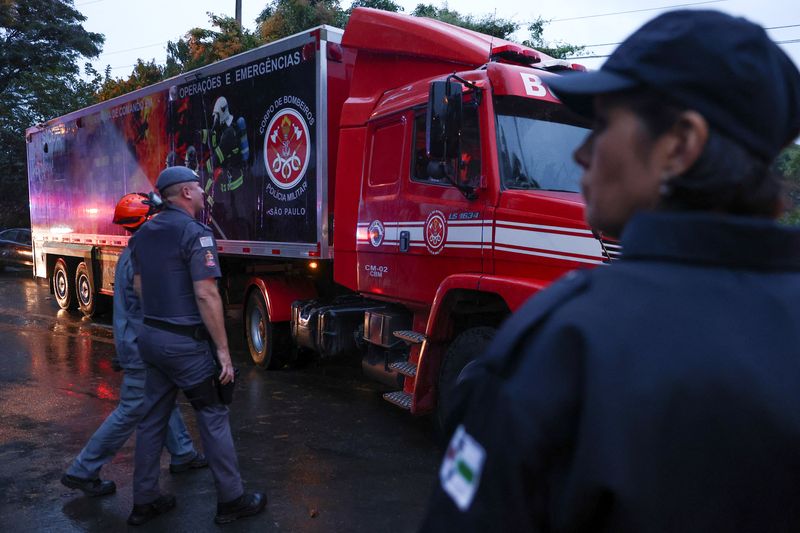By Gabriel Araujo, Andre Romani, Luana Maria Benedito
SAO PAULO (Reuters) -A regional turboprop aircraft crashed close to Sao Paulo in Brazil on Friday, killing all 61 individuals on board, the airline stated.
Regional service Voepass stated the aircraft, sure for Sao Paulo’s worldwide airport, took off from Cascavel, within the state of Parana, and crashed at round 1:30 p.m. (1630 GMT) within the city of Vinhedo, some 80 km (50 miles) northwest of Sao Paulo.
Video shared on social media confirmed the ATR-72 plane spinning uncontrolled because it plunged down behind a cluster of bushes close to homes, adopted by a big plume of black smoke.
Close by resident Daniel de Lima stated he heard a loud noise earlier than trying exterior his condominium in Vinhedo when he noticed the aircraft in a horizontal spiral.
“It was rotating, but it wasn’t moving forward,” he informed Reuters. “Soon after it fell out of the sky and exploded.”
Metropolis officers at Valinhos, close to Vinhedo, stated there have been no survivors and just one residence within the native condominium complicated had been broken whereas not one of the residents had been harm.
“I almost believe the pilot tried to avoid a nearby neighborhood, which is densely populated,” de Lima stated.
Authorities didn’t instantly say what had triggered the crash, although the top of Brazilian aviation accident investigation middle Cenipa stated that the aircraft’s so-called “black box” containing voice recordings and flight information had been recovered from the positioning.
The video of the crash confirmed clear climate, with the forecast for the realm calling for mild rainfall and winds of 10 km per hour (6 mph).
John Hansman, a professor within the division of aeronautics and astronautics at Massachusetts Institute of Expertise, reviewed among the footage shared on social media and with out having reviewed flight information stated the crash didn’t seem to have been attributable to climate.
“It may have been an engine failure on one side that was mismanaged by the crew,” he stated. “It could be the thrust of the remaining engine that started the rotation downward.”
U.S. aviation security marketing consultant and former industrial pilot John Cox stated he would need to validate the Flightradar information, which confirmed a whole lot of gyrations in pace, however regardless, one thing “really significant” occurred to trigger the aircraft to spin when it got here down.
“We don’t spin airliners,” Cox stated. “So that says at some point it stalled and then the flight crew lost control of it. But it appears that there may have been some catastrophic event before that loss of control.”
Cenipa head Marcelo Moreno cautioned in a press convention that it was nonetheless too early to find out the reason for the crash.
“From what we can tell so far, the aircraft did not reach out to traffic control reporting an emergency,” Moreno stated.
Voepass, Brazil’s fourth-largest airline by market share, stated it couldn’t present any extra data on what triggered the aircraft to crash. It had initially reported 62 individuals aboard the plane, although native media interviewed a person who stated he had missed the flight.
In whole, the aircraft was carrying 57 passengers and 4 crew, Voepass stated.
Franco-Italian ATR, collectively owned by Airbus and Leonardo, is the dominant producer of regional turborprop planes seating 40 to 70 individuals.
ATR informed Reuters that its specialists had been “fully engaged” with the investigation into the crash and its clients.
The motor on the aircraft was a PW 127 produced by Pratt & Whitney Canada, its mother or father firm RTX Corp confirmed to Reuters. RTX stated that it had provided help within the investigation.

Each French and Canadian investigators will take part within the investigation, Moreno stated. Europe’s security regulator additionally stated it could provide technical help.
The crash is Brazil’s deadliest since 199 individuals had been killed in 2007 on a flight operated by TAM, which later joined LAN to develop into what’s now LATAM Airways (NYSE:).




